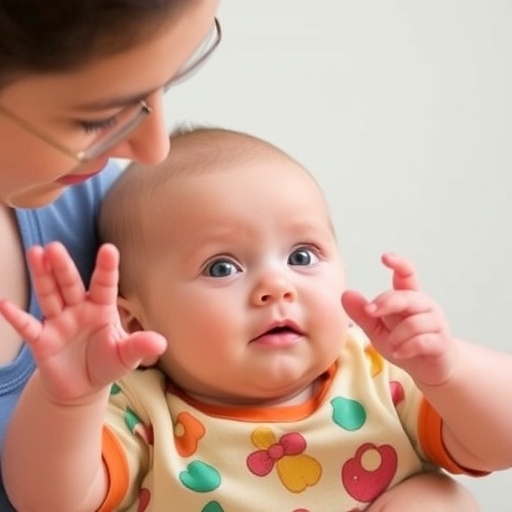In the formative months of life, an infant’s capacity to engage with the environment appears fleeting, yet emerging evidence reveals that specific linguistic and nonverbal cues dramatically amplify their focus and learning potential. A recent landmark study from the University of California, Davis, has illuminated the powerful synergy between naming objects and spatial language in capturing the attention span of nine-month-old infants, with gestural accompaniment further enhancing this effect.
This study, meticulous in design and rich in observational detail, probes the nuanced interplay between early word comprehension and infants’ attentional mechanisms. Researchers observed infants interacting naturally with their caregivers during a structured play session involving a multi-animal puzzle. The infants’ gaze was continuously tracked via head-mounted eye-tracking technology, delivering precise temporal data on how long an infant focused on individual objects as parents used varying categories of words and gestures.
The fundamental discovery was that when caregivers used object labels alone — simple nouns such as “bear” or “lion” — infants’ attention increased modestly in duration compared to nonspecific speech. However, the incorporation of spatial terms like “here” and “there” alongside these labels significantly prolonged infant focus, doubling the attention span relative to baseline speech. Crucially, when parents combined both labeling and spatial language, infants maintained gaze on the targeted objects noticeably longer, with an average dwell time exceeding six seconds.
Delving deeper, the study demonstrated that pairing this dual verbal input with nonverbal cues, particularly pointing gestures directed toward the object in question, elicited the most pronounced engagement. In these multimodal communication instances, infants’ focus extended to an average of over eight seconds, a substantial increase given typical infant attentional windows. This suggests a cascading effect where the alignment of verbal labels, spatial references, and gestures provides a rich, multisensory scaffold for early cognitive processing.
The implications of these findings resonate far beyond the immediate context of infant-caregiver interaction. Early attentional engagement is foundational to cognitive development, particularly spatial reasoning, which underpins navigating and understanding the physical world. By anchoring object recognition to their spatial context via language and gesture, infants seemingly begin to construct a sophisticated mental map of their surroundings well before they articulate their first words.
Methodologically, the use of portable, head-mounted eye trackers allowed the researchers to capture naturalistic behaviors in a setting that closely mirrored everyday play, circumventing limitations of laboratory stimulus presentation. This approach provided temporally precise quantification of gaze duration and fixation points, offering robust empirical evidence for the proposed hypothesis regarding the role of spatial and labeling language interplay.
The study sample consisted of 49 North American caregiver-infant dyads, focusing specifically on nine-month-olds due to developmental milestones occurring around this age. At nine months, infants exhibit burgeoning abilities to follow gaze cues and respond to joint attention, making this period particularly fertile for examining early language-spatial cognition links.
Statistical analyses revealed clear distinctions in average fixation durations across linguistic conditions. Non-label, non-spatial language resulted in an average focus time of approximately 3.1 seconds. Label-only terms increased this to 3.9 seconds, while spatial words alone yielded a 3.6-second average. The substantial leap to 6.1 seconds occurred only when spatial and label words were combined, underscoring the interactive potency of these linguistic elements. Gestural accompaniment further augmented this to 8.4 seconds, emphasizing the multi-dimensional nature of infant attention capture.
From a developmental psychology perspective, these findings reinforce the theoretical framework that early language acquisition and spatial awareness are intertwined processes. When caregivers intuitively embed spatial cues in their communication, they are effectively scaffolding advanced neural circuits associated with spatial reasoning and category learning.
Furthermore, the longitudinal consequences of these early interactions could be profound. Extended attention to objects within a spatial context facilitates memory consolidation and enhances perceptual discrimination, potentially influencing later outcomes in mathematics, navigation skills, and general problem-solving capabilities.
In practical terms, this research advocates for enriched communicative environments for infants that blend verbal labels with explicit spatial references and gestures. Such environments may nurture cognitive development trajectories by optimizing attention and engagement during critical periods of brain plasticity.
Senior author Lisa Oakes, a distinguished professor of psychology at UC Davis and leader of the Infant Cognition Lab, emphasizes the importance of these findings in bridging gaps between language input and developing spatial cognition. The study not only contributes to the academic discourse on infant learning but also offers actionable insights for parents, educators, and clinicians seeking to enhance early developmental interventions.
Funded in part by the National Science Foundation, this work represents a significant step towards understanding the mechanisms that underpin early cognitive growth. The cross-disciplinary nature of the study, incorporating elements of psychology, linguistics, and neuroscience, highlights the multifaceted challenges and opportunities in decoding infant cognition.
As the first investigation to systematically measure infants’ responses to combined spatial and labeling words, this study opens avenues for future research to explore dimensionality in language input and its neurodevelopmental correlates. The incorporation of technology such as eye-tracking continues to revolutionize the precision and ecological validity of developmental research methodologies.
In sum, this groundbreaking research underscores the dynamic ways in which language and gesture collaboratively anchor an infant’s exploratory gaze, setting a foundation for lifelong learning and interaction with the physical and social world. Understanding these subtle yet powerful cues provides essential knowledge to optimize early communicative practices that shape infant cognitive pathways from their very first months of life.
Subject of Research: People
Article Title: [Not provided in source]
News Publication Date: 1-Sep-2025
Web References: http://dx.doi.org/10.1037/dev0002068
References: Russell, A., Kızıldere, E., Nelson, C. M., Estes, K. G., & Casasola, M. (2025). [Exact article title not provided]. Developmental Psychology.
Image Credits: [Not provided]
Keywords: Psychological science




